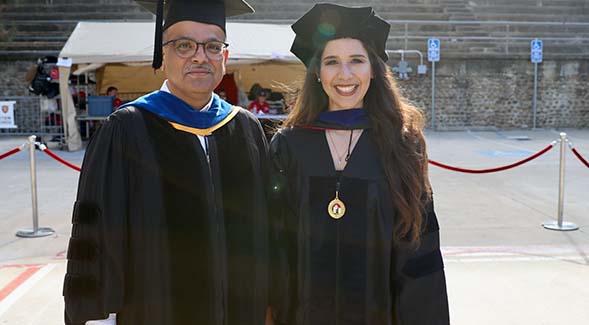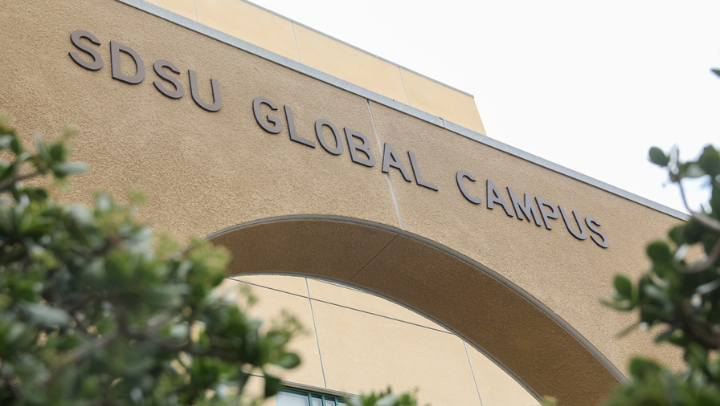Visiting International Undergrad Turned Ph.D. Graduate Finds Niche at SDSU
Paulina Daz-Montiel arrived in 2014 as an international student. Since then, shes earned her masters and become the first female Ph.D. from the joint doctoral program in structural engineering.

“Paulina was the best graduate student I have advised in my 20 years at SDSU.”
For Paulina Díaz-Montiel, what started as a study abroad experience in San Diego from her hometown of Mexicali turned into an eight-year academic pursuit that culminated in earning her doctoral degree.
This spring, Díaz-Montiel earned a doctoral degree in structural engineering from San Diego State University and the University of California San Diego, becoming the first female Ph.D. from the joint program.
Díaz-Montiel first came to Montezuma Mesa in 2014 as a visiting undergraduate student from CETYS Universidad Mexicali campus. At the time, she was studying mechanical engineering.
That was until she took a course with aerospace engineering professor Satchi Venkataraman, who invited her to his aerospace lab as a student. “His class changed the trajectory of my career,” said Díaz-Montiel.
Venkataraman’s expertise in structural optimization and composite materials allowed for Díaz-Montiel to learn more about structures, which greatly interested her. Her experience learning about computer models, how we analyze structural failure, and different types of civil and aerospace structures particularly stayed with her: “His class changed the way I saw structures.”
After earning her bachelor’s degree in mechanical engineering, she returned to SDSU and joined Venkataraman's Composites Research Structures Laboratory as an M.S. student of aerospace engineering, with an emphasis in structural mechanics. Her research has tried to develop insights into how manufacturing defects affect strength and durability of lightweight carbon fiber reinforced polymer composites, a material that is often used in aerospace, automotive and energy applications.
Simplified, Díaz-Montiel studies how manufacturing affects composites: “We don’t fully understand how composites fail yet, so it’s important to look into it to promote a more sustainable future.”
Having worked with Venkataraman’s lab for eight years impacted Díaz-Montiel tremendously, she said. “He’s helped me become an independent researcher, think critically, and grow in my passion for teaching students.” He also enabled her professional growth with teaching opportunities, she said — over her doctoral program, she taught statics courses to undergraduates, and mentored students from various backgrounds.
“Paulina was the best graduate student I have advised in my 20 years at SDSU,” said Venkataraman. "Over the last eight years, I saw her grow from a curious undergraduate student to a confident independent researcher, teacher and scholar.”
Next steps
Her next steps include joining the University of San Diego’s (USD) Department of Mechanical Engineering as a tenure track assistant professor in fall 2022. She looks forward to staying in San Diego, which she calls a “dream” not only for the great weather and proximity to her hometown, but for the population of students she’s able to work with and for the cross-border collaborations it allows. “I love the students in San Diego because I often find myself connecting to their backgrounds and challenges they may have had in their lives.”
At USD’s Shiley-Marcos School of Engineering, Díaz-Montiel will teach courses in mechanics and materials and plans to promote cross-collaboration between SDSU and USD with joint partnerships in research projects having to do with the effect of defects on composites.
“We have begun to explore some very exciting ways that we can collaborate with SDSU engineering and look forward to many great years of partnership,” said USD Dean Chell Roberts. “We are also delighted to have Dr. Díaz-Montiel join USD. She has such wonderful potential as a teacher and as a scholar.”
Díaz-Montiel’s research lab will develop experimental testing programs and computational progressive failure analysis tools for advancing the manufacturing of sustainable composite structures that can be employed in a variety of applications: from efficient aircraft vehicles to innovative infrastructure.
“I will miss having her in my research group, but am happy to know she will be closeby and plans to continue to collaborate with us,” said Venkatamaran.
Díaz-Montiel couldn’t agree more: “Collaborations with researchers from different backgrounds are where the greatest research happens.”



